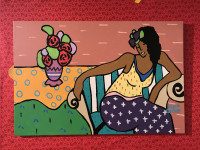June Collie and the Construction of Beauty
10/02/2018

There is one thing that is absolute about June Collie’s work: it makes me happy. Its layered, bold tapestries and lush, bright color transport me to my own imagined boudoir, where I languidly rub scented oils on my skin as I lay among soft silk pillows. I so easily see myself in her work.
The bodies she paints are like mine, my mother’s, my grandmothers’ – they are familiar, easy-going and articulate beauty with a confidence that I have seen only in generations of unencumbered women. Her work captures this self-love; the sweetness of brushing your hair as you run bathwater, or the pleasure of listening to your favorite record as you drift off to sleep. Her work reminds viewers that they are the subject of their own desires and that their lives and bodies are beautiful in and of itself. Her most recent interactive installation, “Dollhouse”, created for the D’Aguilar Art Foundation’s “pARTicipate!”, does just this: it encourages the viewer to celebrate the beauty they find within themselves.
When it comes to art and the people artists depict in their work, the very act of capturing a particular form is to argue that it is beautiful. Unless of course the intended argument is that it is inherently not, but that is not what Collie does. Her artwork celebrates the beauty of her subjects in the most hedonistic of ways; it merges them with signifiers of sensual indulgence, such as ornate cloths, teas, or a spinning record player. Hedonism’s conflation of beauty and pleasure seems to be a theme by which Collie argues the beauty of her subjects – implying that the women she depicts are just as capable of giving pleasure – visual, sexual or otherwise – as the tapestries she layers in the background of her scenes. That is not to say however that the women within her work are depicted only as objects of desire. June Collie’s subjects are not victims of a gaze that strips them of their humanity. Rather, she argues that her subjects are beautiful by showing them interact with the lavish scenes that Collie creates for them, ultimately arguing that there is beauty in self-love, self-care and enjoying the pleasures of the world around you.
The premise of “pARTticipate!” is primarily to encourage visitors to do just this: enjoy the art within the exhibit surrounding them. The gallery’s curator, Tessa Whitehead, asked Collie and four other Bahamian artists – John Cox, Kendra Frorup, Natascha Vazquez and Margot Bethel – to create pieces with which the viewer can interact in the show. June Collie’s “Dollhouse” installation does this by depicting a scene which one would normally see surrounding her figures: in it, she has ornate wallpapers and hanging tapestries centered by a table set for teatime. The piece invites the viewer to interact with the work as its subject and play with the tapestries presented. Through their participation, the “subject” acknowledges their own beauty, ultimately solidifying the premise by the interaction with the sensual symbols that Collie presents.
It is important to note that to achieve the purpose of this installation the subject must exercise their own agency. Through interacting with “Dollhouse”, the participant does not depend on the gazes of spectators outside of the “painting” to affirm the beauty of the experience. They do it by enjoying themselves and by playing with signifiers of self-love and care. Thus “Dollhouse” argues against definitions of beauty contingent on viewpoints of others, especially ones that stem from a Eurocentric gaze. Within this set, beauty is not defined by a white man, but rather, the subject’s celebration of themselves and their own experience.
Contemporary African-American artist Mickalene Thomas points out the danger in categorizing beauty by a set of parameters rooted in the Eurocentric gaze, stating: “We respond to beauty, its seduction and attraction, yet what it has done culturally to people that are subject to universal codes of beauty has been devastating.” (Contemporary Photography: (Re)Presenting Art History, 203). Thomas’ artwork also explores the beauty of Black women by placing them in scenes of rich, sensual tapestries. In fact, one of her photographs¸ Courbet 3, is very similar to a Collie in composition: in it we see two nude subjects lay backwards on a mattress, surrounded by hanging cloth. She known for addressing art history that hails concepts of beauty that reject African features, and much like June Collie, she merges the figure with the sensual scenes, suggesting that these women are also capable of giving visual pleasure.
As the subject of “Dollhouse”, the participant rejects these harmful standards of beauty that has permeated our culture for centuries. This installation gives the viewer the agency to define the beauty within themselves. Collie’s career has thus far highlighted Black features and women who are historically ignored in conversations about what is beautiful. She pushes this idea further with “Dollhouse”. By stepping into a June Collie painting, surrounded by the rich, bold color and textures, the subject ultimately is able to define their own beauty though play. Collie knows how important it is to see yourself in the artworks that gives you pleasure, and in this exhibit, she invites people to literally be the subjects of their own paintings and discover the inherent beauty within themselves.
